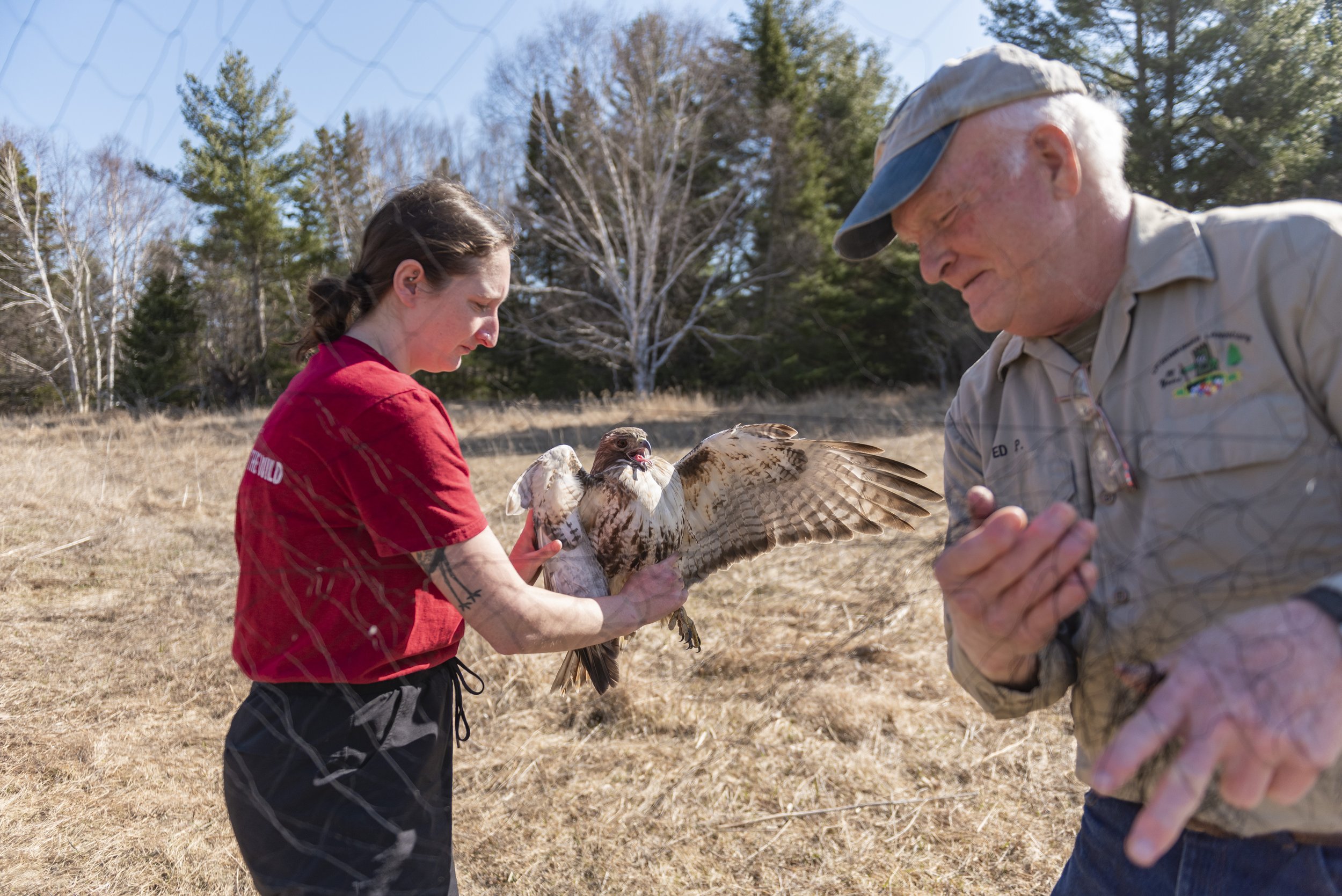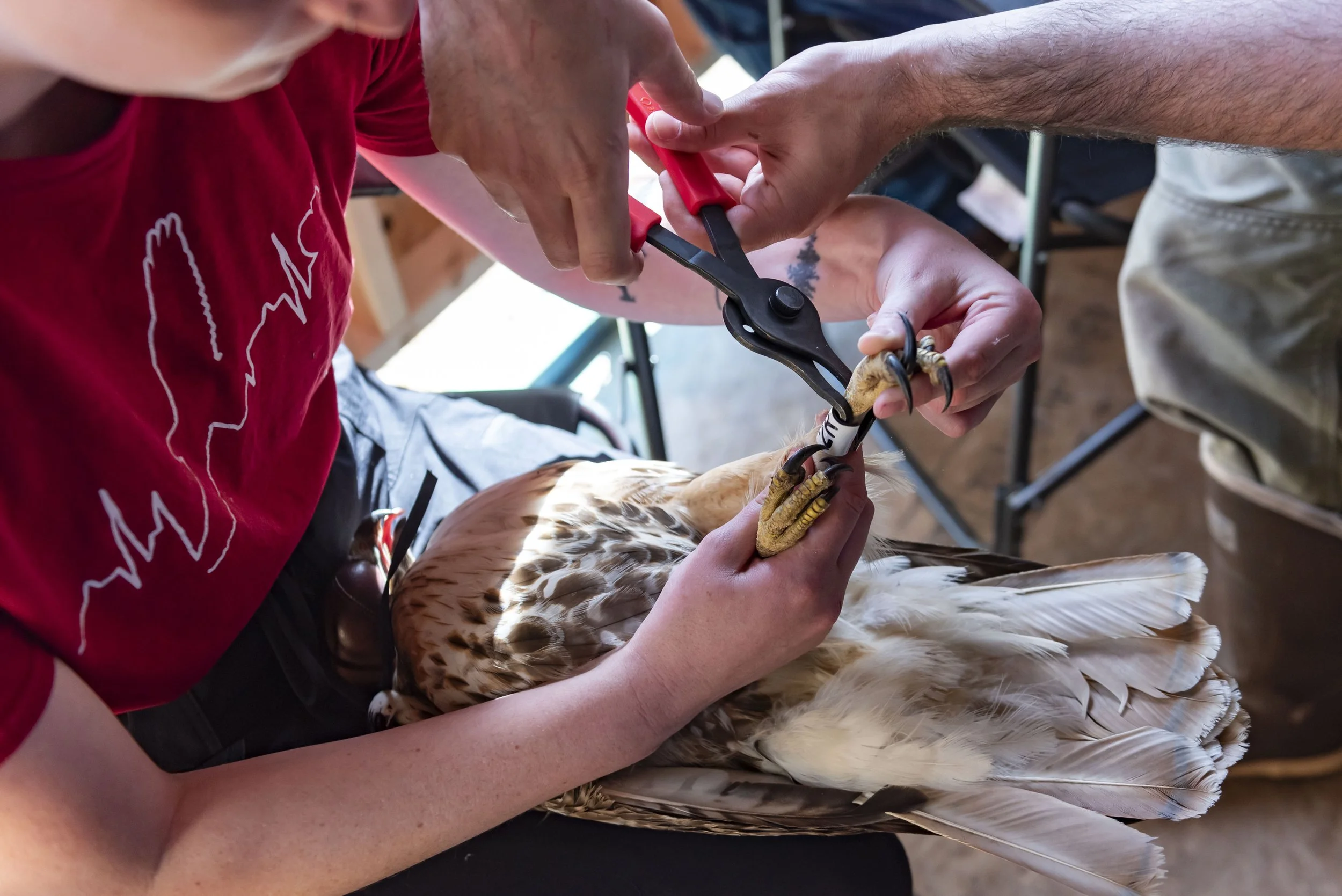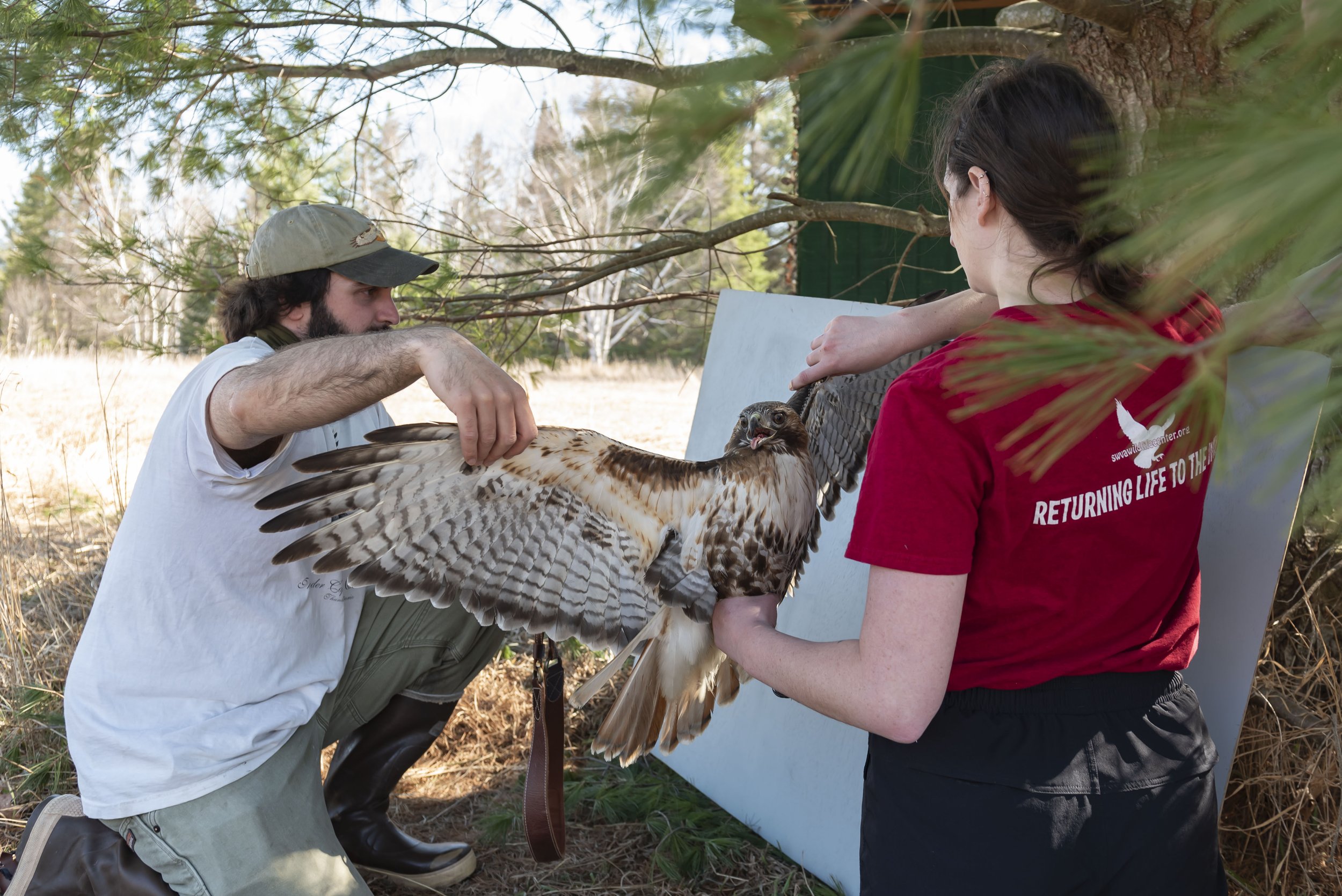Researching Raptors
MACKINAC STRAITS RAPTOR WATCH COUNTS, BANDS, STUDIES BIRDS OF PREY DURING SPRING MIGRATION
The Straits of Mackinac are a point of convergence for travelers moving north or south between Michigan’s upper and lower peninsulas. The highly trafficked crossing point at the Mackinac Bridge is not exclusive to humans, as more than 15 species of raptors, the hawks, eagles, falcons, and owls, fly across this span from March through June on their journey north to breed. Reluctant to cross large bodies of water, raptors traveling through lower Michigan are funneled north, guided by Lake Huron and Lake Michigan which act as geographic bumpers to the east and west. Where the two lakes meet, so do the raptors.
The nonprofit Mackinac Straits Raptor Watch is dedicated to studying the birds of prey that migrate through the area. With every migration in spring and fall, the group counts, tracks, and bands raptors that pass through from their wintering grounds in the south and their breeding grounds in the north. Education, conservation, and outreach are pillars of the organization, and three efforts guide their work during the spring season: Northern saw-whet owl and raptor banding, raptor and waterfowl counts, and tracking the migratory pathways of red-tailed hawks. The research contributes to a greater scientific understanding of the birds of prey and helps Mackinac Straits Raptor Watch educate the public about the raptors’ role in the ecosystem and advocate for their conservation.
Owl Banding A rhythmic too-too-too sound is played on a loop in the center of a triangle of mist nets in the forest around Historic Mill Creek Discovery Park. The recorded northern saw-whet owl call serves as a lure that draws the nocturnal raptors toward the nets. Every 30 minutes, Danny Erickson, a raptor biologist working with the MSRW, leaves the comfort of his office for the cold, dark night to check each net for entangled birds. It’s an unpredictable, variable endeavor that requires persistence and patience. Ed Pike, a founding member of the organization, oversees the research projects, including the owl banding. Conducted in the spring since 2015, the effort is less intensive than the fall banding held at Point LaBarbe in St. Ignace. Fewer birds travel through the area and are caught during the spring count, which begins in late March and continues through early May. The population is smaller during this period, as many of the owls, particularly the young ones, do not survive the winter. On the best night, Mr. Erickson found 13 saw-whets. On other nights, he didn’t find any. During inclement weather, usually high winds or intense rain, he doesn’t even set the nets. “This is what’s referred to as a constant effort station,” Mr. Pike said. “That’s why we have certain dates that we start and end at. Then every night, from dusk until dawn, the nets are open if the weather is good.” With every owl he catches, Mr. Erickson takes specific measurements. He gently removes the owl from the mist net and secures the small bird inside an empty Pringles can, keeping it safe and calm in the dark.
Back at the office, he weighs the bird while it is still in the can, then removes it to secure a lightweight, aluminum band around its leg. The band has an identification number specific to each bird that is recorded and regulated by the Bird Banding Lab through the U.S. Geological Survey. He then takes a wing chord measurement which captures the length of the wing in its natural, curved state, and the length of its tail. The owls are not harmed during any part of the process. When handled gently and calmly, the birds behave the same. Using the weight and wing chord, Mr. Erickson can determine the owl’s sex, as males are significantly smaller than females. To age the bird, he examines the owl’s wing feathers with an ultraviolet light. Owls shed only a portion of their flight feathers during their annual molt, while retaining the rest for up to three years. The new feathers contain the chemical porphyrin, which fluoresces bright pink under the ultraviolet light. A saw-whet with feathers that appear all pink is in its hatch year, while an owl with an irregular pattern of fluorescent and non-fluorescent color is older than two years. Recording the age and sex of the birds helps scientists and conservationists understand the health and dynamics of the saw-whet population. “Working with birds is pretty special,” Mr. Erickson said. “It is a privilege to be handling them and finding out this information.”
Raptor Banding Banding continues during the day, as Nick Alioto and Hannah Glass catch, band, and measure the diurnal (daytime) raptors. In a newly constructed blind set in a field east of Mackinaw City, Mr. Alioto and Ms. Glass sit in relative silence and stillness through the morning and into the afternoon, watching the sky for raptors flying overhead. Inside the camouflaged blind, the researchers act as puppet masters, controlling the elaborate net system with two ropes leading into the building. A pigeon and starling are secured in the trap to act as a lure for the birds of prey but are not harmed in the process. They are rotated out of the trap and replaced with another of their species every 45 minutes to an hour, ensuring that the birds are not worked for an extended period. Like Mr. Erickson, Mr. Alioto and Ms. Glass must be patient. Emulating the eyesight of their target species, they must watch the sky like hawks. Whispered identifications are passed between them as they alert each other to a bird’s location on the horizon. Depending on where the bird lands, a release net is triggered to trap it and one of the researchers must make a hasty run toward the mist net to make sure the raptor doesn’t escape. The birds are not harmed in this process. Once secured, the bird processing commences in standard fashion. Large raptors, like red-tailed hawks, are held in coffee cans, or similarly sized vessels. Smaller birds, like sharp-shinned hawks, can be put inside Pringles cans like the saw-whets. Researchers record the weight while the bird is still in the can, then choose an appropriately sized band to secure around the bird’s leg. From there, they inspect the beak, talons, wings, and tail, and take various measurements. The researchers also check the bird’s crop, which is a muscular pouch near their throat that stores food. By pressing a finger to the bird’s upper chest, they can determine if the crop is full or empty. The researchers will catch, band, and measure any raptor they can.
Through the 2023 season, they have caught a variety of these birds, including red-shouldered hawks, northern harriers, Cooper’s hawks, sharp-shinned hawks, American kestrels, northern goshawks, and merlins. Red-tailed hawks are of particular interest to Mr. Alioto, as this year marks his third season capturing, banding, and, in some cases, attaching transmitters to the birds. A graduate student at Michigan State University, Mr. Alioto studies the movement ecology of red-tailed hawks migrating through the Straits of Mackinac region in collaboration with the university, Mackinac Straits Raptor Watch, and the red-tailed hawk project. Generous Raptor Watch donors have helped fund his project, as the transmitters he attaches to certain red-tailed hawks cost about $1,400 a piece. When a red-tailed hawk is caught meeting certain specifications, Mr. Alioto fits a lightweight, solar-powered backpack onto the bird. It is a harmless contraption that doesn’t interfere with the bird’s flight, nesting, eating, or other behaviors. As the hawks continue their migration, the transmitter sends a location signal periodically while in range of a cellular tower. As the hawks move further north, cellular towers are rare, but the transmitter saves the location data and uploads it as soon as a tower is in range. Mr. Alioto can access this time stamped data online, including their altitude and flight speed, tracking the path of each bird indefinitely. The solar-powered transmitters are unique in their longevity, as similar devices are typically battery powered, meaning their lifespan is limited. With just 10 transmitters, Mr. Alioto must be selective in which birds he attaches them to. In mid-April, Mr. Alioto and Ms. Glass trapped two adult, dark-morph red-tailed hawks. Spotting them in the Straits of Mackinac region is rare, and trapping two was an experience equivalent to winning the lottery, Mr. Alioto said. The migratory paths and space use of red-tailed hawks is relatively understudied, as the birds are so common, they are often overlooked. There is even less information available about the dark-morphed variety. The transmitters will help to fill information gaps and lead to better understanding of these birds.
Raptor and Waterfowl Counts Stationed behind the Mackinaw City Recreation Center, Calvin Brennan keeps his eyes on the horizon with a spotting scope and binoculars. He counts and identifies raptors flying through the area, careful to count each bird only once. Some days can be more challenging than others. Unfavorable conditions can limit the number of birds flying, but under the right conditions, thousands of birds can be spotted. Some 18,000 broad-winged hawks were counted Friday, April 28. The raptors are counted every spring and fall, but new this year were three specialty weekends: Golden eagle weekend Saturday, March 18 and Sunday, March 19, red-tailed hawk weekend Saturday, April 8, and Sunday, April 9, and broadwinged hawk weekend Saturday, April 29, and Sunday, April 30. Based on data collected from previous counts, Raptor Watch planned the weekends in accordance with the peak migration times of the three species. The maximum daily count for golden eagles was recorded March 21, 2015, with 85 individuals identified. The maximum for red-tailed hawks was 4,966 individuals April 13, 2016, while the maximum count for broad-winged hawks, 12,320, was recorded May 4, 2014. Naturalist Sarah Reding is on site every Friday, Saturday, and Sunday to answer questions for curious visitors, but on these weekends, she provided information specific to the honored species. As the birds tend to migrate in flocks, the specialty weekends provided an excellent opportunity to observe kettling, the name for groups of raptors circling in the thermal currents to gain altitude before gliding across the water. The 2023 spring raptor count began March 5 and will continue through June 5. Guests range from experienced raptor enthusiasts to tourists who happened upon the count accidentally. The count is open to everyone, and on weekends binoculars are available to borrow. For most visitors, learning about how the birds are “funneled” through the center of the state to the Straits of Mackinac is new and exciting information. Through the spring season, visitors may have the opportunity to encounter raptors up close. While the raptor banding takes place nearby, Mr. Alioto, Ms. Glass, or other Raptor Watch representatives will often take the caught birds, after they have been processed, to the count, providing the guests with a rare, personal encounter with a raptor they may have only seen flying above them.
A spring raptor count is also held on Mackinac Island, led by seasonal counter Gracie Sangmeister. From Fort Holmes, the Island’s highest point, the raptors can often be viewed from above, offering a unique perspective that counters do not often experience. A similar counting effort is also conducted focusing on area waterfowl. As the region is defined by the meeting of Lake Huron and Lake Michigan, learning more about the species, numbers, habits, and behaviors of such birds is essential to protecting and understanding the Straits of Mackinac environment. Oliver Kew, the spring waterbird counter for Mackinac Straits Raptor Watch, alternates between St. Ignace and Mackinaw City, counting from each side of the straits every other day. At least 10 years of data collection should take place at a particular location before judgements, estimates, and analyses can be made, according to Mr. Pike. The spring owl banding initiative is three years shy of that benchmark, but the data can still be contextualized in comparison to nationwide studies. The local Raptor Watch collaborates with the Hawk Migration Association of North America to analyze the raptor data from across their spring and fall initiatives and to provide nationwide context for understanding its significance. Before Mr. Pike helped to organize Mackinac Straits Raptor Watch in 2004, raptor activity in the Straits of Mackinac region was not monitored. As a migration superhighway, the data collected and shared from the area contributes to a fuller, more thorough understanding of these birds’ biology and their ecological roles. In turn, that information can be shared with the public, giving them a better understanding of the wildlife around them. With public investment, conservation efforts can be targeted and more effective. To become a member of or donate to Mackinac Straits Raptor Watch, donate, visit mackinacraptorwatch.org.












